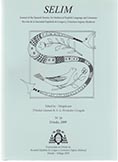Abstract
Literary renderings both in written and oral forms would be regarded during the Middle Ages as enactments of an individual moral and intellectual evolution linked to the eff ects of memory on the human soul. Augustine’s insightful depictions of the works of memory insisted on the visual quality of such a mental process, thus linking it to the writing and reading activities. When reviewing the imagery regarding this fi eld, the fi gure of memory appears related to specifi c locations or habitats for images and words. Of particular interest is the coincidence of such metaphors to those attributed to the fi gure of Fame in classical literature, developed by Chaucer as he also explored the role of memory in the rise of a conscious individual writing positioning. This paper proposes to analyze Chaucer’s “The House of Fame” in the light of Augustine’s rendition of memory. Chaucer used fame as the embodiment of the preservation of public name in memory, regarding its locations as repositories of the legendary past in late medieval collective memory. The paper presents Chaucer’s house of Fame as the place from which he starts a dialogue with past literature and history and with himself and the reader as recipients of that common legacy.
Keywords: Chaucer, The House of Fame, Oral and written medieval literature, Memory, Saint Augustine.




